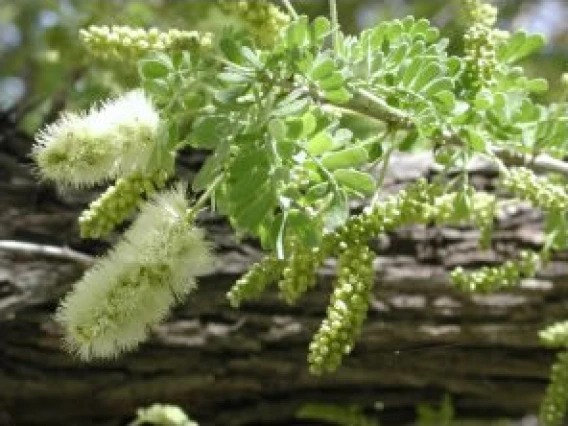


Botanical Name: Senegalia greggii
Family: Fabaceae
Common Names:
English: Catclaw acacia
Spanish: Uña de gato
O'odham: U:paḍ
Rain Garden Zone: S. greggii thrives in the terrace Rain Garden Zone; however, it can grow well in the top Rain Garden Zone as well.
Reproduced with permission from "Rainwater Harvesting for Drylands and Beyond" by Brad Lancaster, HarvestingRainwater.com
Flowering Season: Spring
Harvest Season: Monsoon
Planting Season: Summer
Characteristics: S. greggii is considered a large shrub or small tree reaching 20' in height with a broad crown. The bark is thin and grayish-black with shallow furrows. The leaves are grayish-green and bipinnately compound, with an oblong shape ranging 2.5-8 centimeters long. The flowers of S. greggii are a creamy white with aggregated spikes. The fruit is a reddish, papery legume reaching between 5 and 10 centimeters. (3)
Landscape Cultivation: The pronounced taproot of S. greggii makes transplantation difficult; instead, it should be propagated by seed. Collect seeds in late summer and early fall. Germination may be improved wiht hot water scarification (3). S. greggii is extremely drought tolerant; once established, little to not supplemental watering is needed. Plant in full sun. (2)
Ecology: Catclaw acacia provides food, shelter, nesting sites, and material to a wide range of wildlife; notably, deer, rabit, and birds feed on the catclaw acacia. In the summer, catclaw acacia consists of 18% of the mule deer's diet. Catclaw acacias provide crucial shelter and shade to a number of desert animals, including bighorn sheep, collared peccaries, white-throated woodrat, and kangaroo rat (2).
Ethnobotany:
Food:
The seed pods of the catclaw acacia are a source of protein, calcium, and phosphorus (2). Traditionally, the seeds of the catclaw acacia tree have been used to make pinole (3). Pinole is a dish that typically consists of roasted, ground corn mixed with sweeteners and spices, for use as a powder, beverage, or portable cake (4). Additionally, bees that feed on the nectar of the catclaw acacia produce a sweet honey, commonly called "Catclaw Honey." (3). Although the seeds of other natice legume trees, such as velvet mesquite, are typically preferred to the somewhat bitter taste of catclaw acacia, seed can be prepared and eaten in much the same way.
Domestic Animals:
Cattle and other livestock grazes on the seeds and foliage of the catclaw acacia, especially during periods of new growth (2).
Other:
Medicinally, catclaw acacia has many traditional uses. Leaves and pods were dried and ground into a powder to treat minor skin irritations and diaper rash. Pods can be soaked and made into an eyewash to treat conjunctivitis. Teas can be made from the flowers and leaves to treat nausea, vomiting, and diarrhea. Teas made from the root of the tree may be consumed to treat sore throat and coughs (2).
References:
- TOCC Plant Atlas
- Fire Effects Information System
- Wildlower.org
- Adán Medrano
- Lancaster, B. (2006) Rainwater harvesting for drylands and beyond. Tucson, AZ: Rainsource Press.
For more information on this plant, see the Campus Arboretum species descriptions.
Go to the next tour stop: desert willow page or Return to the main Dunbar Spring tour page

